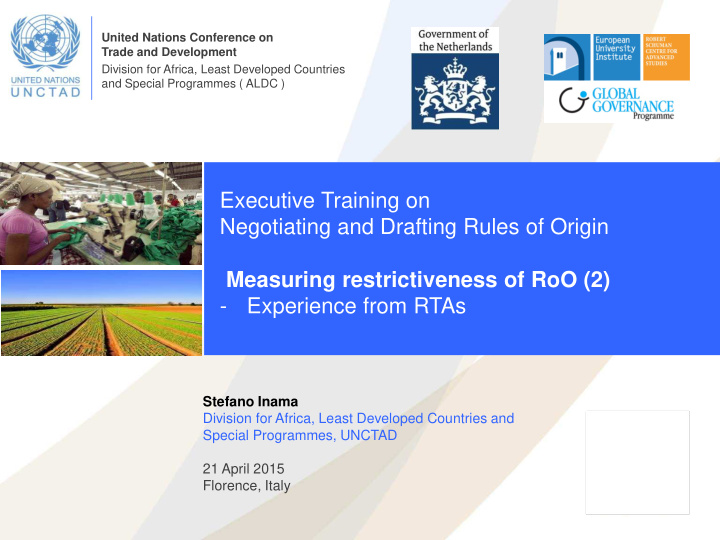



United Nations Conference on Trade and Development Division for Africa, Least Developed Countries and Special Programmes ( ALDC ) Executive Training on Negotiating and Drafting Rules of Origin Measuring restrictiveness of RoO (2) - Experience from RTAs Stefano Inama Division for Africa, Least Developed Countries and Special Programmes, UNCTAD 21 April 2015 Florence, Italy
Trade creation and trade diversion effects in FTAs and RoO trade effects [1] Trade creation is defined as the reduction in the domestic production of goods, which are substituted by imports from partner countries. [2] Trade diversion is defined as the reduction of imports from countries that are not members of the FTA and which are substituted by imports from Partner countries.
Trade Effects of Rules of Origin in FTAs • THE MORE STRINGENT THE RULES, THE MORE DIFFICULT TO COMPLY, THE LESS TRADE CREATION IS LIKELY TO OCCUR. • THE MORE STRINGENT THE RULES, THE MORE TRADE DIVERSION IS LIKELY TO OCCUR WHEN LESS EFFICIENT INPUTS FROM THE PARTNER ARE REPLACING MOST EFFICIENT SUPPLIERS FROM THIRD COUNTRIES, UP TO THE POINT WHERE IN THE ABSENCE OF PARTNER INPUTS THERE IS NO TRADE CREATION, NO TRADE DIVERSION.
Trade Effects of Rules of Origin in FTAs Trade Trade diversion creation Stringency of Stringency of rules of origin rules of origin
Trade restrictiveness of RoO in Theory
Drafting RoO in FTAs: Do we have a golden model ? • Absence of Multilateral rules • Very few analytical studies. • Forthcoming study by UNCTAD [2014] • Existence of models : NAFTA inspired rules, Pan-Euro RoO • Absence of models in South-South FTAs • Different practices in administering origin
Drafting RoO in FTAs: We just have some lessons learned • The lessons may be drawn from : • Low utilization of a FTA or other preferential PTAs • Changes in practice in the way RoO are drafted since administrations found that some RoO are easier to administer than others. • Need to adapt RoO to fragmentation of production vs. vertical industrial integration • There are those that are learning more and those who are learning less …
First lesson learned: RoO should match Industrial capacity - Trade effects of EU reform EU imports from LDCs and GSP utilization rates Art of apparel & clothing access, HS 61 knitted/crocheted and HS62 not knitted/crocheted Total Imports Utilization Rates (USD Millions) 100% 1'800 90% 1'600 80% 1'400 70% 1'200 60% 1'000 50% 800 40% 600 30% 400 20% 200 10% 0% 0 Utilization Rate HS 61 (left axis) Utilization Rate HS 62 (left axis) Total Imports HS 61 (right axis) Total Imports HS 62 (right axis)
Second lesson learned: RoO should match value chains – Bicycles from Cambodia Utilization Rate USD Millions EU imports and Utilization rate 400 100.0% 350 87.5% 300 75.0% 250 62.5% 200 50.0% 150 37.5% 100 25.0% 50 12.5% 0 0.0% 2006 2007 2008 2009 2010 2011 2012 2013 Total Imports (left axis) Utilization Rate (right axis)
TITLE OF PRESENTATION Third: RoO may be stringent, however utilization high, RoO well drafted, what would happen with RoO less strict ? US Imports from Mexico and NAFTA Utlilization Rates 300 96 Utilization Rate (Right axis) Import value (USD billions) 250 Utilization rate (%) 95.5 200 95 Imports from MEX 150 94.5 2005 2006 2007 2008 2009 2010 2011 2012
Fourth: Is compliance with RoO worth the effort ? US Imports from Canada and NAFTA Utlilization Rates 350 100 Imports from CAN Import value (USD billions) Utilization rate (%) 300 95 250 90 Utilization Rate (Right axis) 200 85 2005 2006 2007 2008 2009 2010 2011 2012
Fifth: Those who seems Learning less: ASEAN Total Imports Utilization rates [2010] BRN KHM IDN LAO MYS MMR PHL THA VNM (Jan-Jun) (Jan-Dec) (Jan-Dec) (Jan-Mar) (Jan-Dec) (Jan-Dec) (Jan-Dec) (Jan-Sep) (Jan-Jun) Form D (USD 20 792 7'385 14 4'976 10 6'694 5'126 1'019 millions) Intra- ASEAN 585 1'682 38'912 404 44'907 1'993 16'270 22'681 7'587 (USD millions) Utilization 3.34 47.1 18.98 3.44 11.08 0.49 41.15 22.6 13.44 (%) Source: SEOM Chairman's report to the AEM-25th AFTA Council Meeting of 10 August 2011, Manado, Indonesia
Sixth: Those who seems Learning less-Reported averages of Utilization Rates in COMESA and SADC [2010] Imports from TFTA and Average Utilization Rates 1000 100 90 850 80.6 Import value (USD millions) 80 73.8 Utilization rate (%) 700 70 60 550 50.7 50 46.3 44.3 400 40 30.5 30 250 21.7 20 100 10 BDI ETH MDG MUS MWI RWA SDN Imports from TFTA Utilization Rate Average Rate (39.7%)
What we can learn ? • RoO matching industrial capacity are trade creating and generate value chains [Cambodia] • RoO may be stringent and predictable leading to high utilization rates in NAFTA. Counterfactual : what if RoO were less stringent ? • The less trade creating: RoO are not predicable and/or do not reflect industrial capacity [ASEAN ,COMESA and SADC]
There are clear lessons in drafting and administering RoO • Abandon use of value added/net cost calculations when using percentage criterion • Use value of materials calculations • Move from across the board to Product- Specific RoO [PSROs].This does not necessarily mean to have PSROs for all products • Distinguish the issue of ‘ form’ from ‘ substance’ when drafting PSROs • Cumulation is not a substitute for liberal RoO • Insert rules on value tolerance and intermediate materials
Lessons learned in Administering RoO • The classical model of the certifying authorities and the certificate of origin • Stamps only (GSP) • Variations: approved exporters and registered exporters(EU reform) • Importer declaration (US) • Stamps and signatures : RTAs in Africa and Asia • There is clear evidence from utilization rates that the latter is the less trade facilitating
Thank you for your attention
Recommend
More recommend